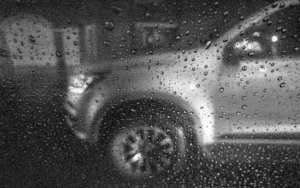If not properly and promptly fixed, a wet car interior can quickly turn from a small annoyance to a major issue. Not only may moisture make your car feel wet and uncomfortable, but it can also quietly creep into upholstery, carpets, and other concealed places, leading to a number of long-term problems. Over time, the retained moisture can cause serious problems, regardless of the cause a strong downpour, an unintentional drink spill, a malfunctioning sunroof, leaking door seals, or even flooding. But how to dry out a car interior?
We’ll show you exactly how to dry out a car’s interior step-by-step in this post. This article will give you useful, effective, and SEO-friendly tips whether you’re dealing with damp carpets, soggy seats, moisture under floor mats, or overall cabin humidity.
The Significance of Rapidly Drying the Interior of a Car
Moisture that accumulates inside your automobile can damage the inside in addition to making the ride uncomfortable. Headliners, seat cushions, carpets, and even the internal electronics of your car may sustain significant damage. Mold and mildew can develop in as little as 24 to 48 hours, dispersing spores throughout the cabin and posing health risks.
In addition to the disagreeable odor, moisture can:
- Weakened carpet adhesives and seat cushions
- cause the seat frames and carpets to corrode.
- cause electrical problems if modules or cables are left uncovered.
- Decrease your car’s resale value
For the interior of a car to remain clean, healthy, and completely functional, drying must be done quickly and completely.
How to dry out a car interior
If moisture is allowed to remain, it can cause mold and mildew to grow, give off lingering musty smells, and deteriorate internal adhesives, fabric, and foam cushioning. Even worse, moisture can cause expensive electrical problems or safety risks if it gets to electrical parts like sensors, control modules, or under-seat wiring. These impacts can have a major impact on your car’s market value in addition to making your ride less comfortable and clean. You’ll have all you need at the end to safeguard the interior of your automobile, get rid of offensive smells, and stop mold from ever growing.
Step 1: Take Out All Soaked and Loose Items
Take everything out of the car first. Take off any personal items, seat coverings, floor mats, and anything else that might have absorbed wet. The drying process may be slowed down by floor mats that retain moisture. You may either clean them separately or let them air out by shaking them out and placing them somewhere dry.
If water has gotten into the back of the car, take out the rear cargo mats or trunk liners as well. These frequently hold onto moisture that is hidden.
Step 2: Quickly Blot Any Extra Moisture
After removing the loose objects, use cotton towels or absorbent microfiber to wipe away as much wetness as you can. To prevent water from penetrating the material further, apply pressure firmly rather than rubbing. Pay attention to the chairs, carpets, and any obvious damp areas.
In order to avoid further saturation and to increase the efficiency of the subsequent drying processes, this step is crucial. You might need multiple towels to absorb the majority of the water in places that are quite wet.
Step 3: Use a Wet/Dry Vacuum
A shop vacuum, also known as a wet/dry vacuum, is an excellent instrument for removing water from the carpet padding and upholstery of your vehicle. To enable the vacuum to extract moisture from the materials’ inside, move it slowly across each surface. Set goals for:
For optimal extraction, go over each area multiple times.
Step 4: Increase Evaporation Speed by Creating Airflow
Only with adequate ventilation will moisture that has been trapped within your car evaporate. If the weather permits, open all the windows and doors. You can also use blowers and fans to encourage circulation.
Place box fans or high-speed fans at the open doors of the automobile, pointing them toward the damp spots. If necessary, use more than one fan to provide cross-ventilation.
If you have a garage, keep the car there for a few hours or overnight with the doors open and the fans running. This procedure is significantly more important to prevent mold growth in colder or more humid climates.

Step 5: Increase Drying Speed Using Heat
Drying speed is greatly increased by including warmth in the equation, particularly in colder climates. Here’s how to use heat safely:
- While the engine is running, turn on the car’s heating.
- Direct the vents toward the seat bases and footwells.
- To allow damp air to escape, keep the windows slightly open.
- Never leave a portable space heater alone or inside the car; instead, use it next to the open door.
- For difficult-to-reach moist areas, use a hair dryer set to low heat.
To prevent warping or cracking, exercise caution when applying heat to leather or vinyl materials.
Step 6: Make use of moisture absorbers or a dehumidifier
A dehumidifier can be an effective remedy for circumstances involving high humidity or ongoing moisture. With the windows and doors closed, leave a small plug-in dehumidifier in the car overnight. This configuration is perfect if your car is in a garage.
As an alternative, leftover humidity can be extracted from the air and surfaces using moisture-absorbing items like baking soda, silica gel, or commercial automobile moisture absorbers (like DampRid). To passively absorb moisture, put them along the dashboard, in cup holders, or beneath the seats.
Step 7: Explore the insulation and under the carpets.
Water can occasionally leak through the carpet and soak the foam insulation underneath. This is a secret location where bacteria and mold can grow quickly.
Lifting the carpet to inspect the insulation is the best course of action if the car was severely flooded or saturated. If the insulation is excessively wet, you might need to replace it or dry it separately. In these situations, a professional detailing service may be necessary to guarantee a thorough dry-out and stop mildew or stink from returning.
Step 8: Clean and Disinfect
Sanitizing the surfaces is crucial after drying. Treat seats and carpets with an antibacterial spray that is suitable for textiles. This aids in the destruction of germs, mold spores, and any remaining microorganisms that cause odor. To get rid of smells even more:
- Dust seats and dry carpets with baking soda.
- Allow it to settle for a few hours or perhaps overnight.
- Do a thorough vacuuming the following day.
For a clean, fresh smell, you can also use upholstery deodorizers or odor eliminators made specifically for cars.
Step 9: Look for Damage or Mold Indications
After everything has dried, give your car a full inspection. Seek out:
White, green, or black patches (maybe mold)
Relentless musty smells
Water rings or stains
Warping in the trim or materials of the dashboard
Additional care or a trip to a professional detailer might be required if you observe any of these symptoms. Particularly for people with allergies or respiratory disorders, mold can grow quickly and be harmful to their health.
Avoid Further Moisture Accumulation
Once the interior of your automobile has dried, follow these actions to avoid moisture issues in the future:
- Look for leaks or breaks in the weatherstripping surrounding windows and doors.
- When it’s raining or snowing, keep your windows closed.
- In the winter, use rubber floor mats to keep snow-soaked footwear from soaking.
- As soon as you see any moist surfaces, wipe them down.
- Use a car cover during intense downpours or park in protected spots.
Think about keeping moisture-absorbing items in the car all year round, particularly in humid regions.
Final Thoughts
How to dry out a car interior? Although drying out a wet car’s inside may appear difficult, it is completely doable with the correct equipment and techniques. To avoid long-term damage, it is crucial to take prompt action by eliminating standing water, encouraging ventilation, applying heat, and utilizing moisture-removal tools. This comprehensive, step-by-step guide will assist you in getting your car back to a dry, comfortable, and healthy state, regardless of the extent of the water intrusion or spill. Regular cleaning, inspection, and moisture control will safeguard your car’s inside and make driving more enjoyable all year long.
Frequently asked questions (FAQ)
1. How can a wet car’s inside be dried off the quickest?
Combining a wet/dry vacuum to remove moisture, high-speed fans to increase circulation, and a portable space heater or car heater to speed up evaporation is the quickest method for drying out an automobile’s interior. If the weather permits, open all the windows and doors; if not, use fans to provide ventilation. Use moisture absorbers, such as baking soda or silica gel, to get rid of any remaining moisture for optimal effects. It’s critical to take immediate action to stop the growth of mold and stink. Combining tools and methods guarantees that padding, seats, and carpets dry more quickly and efficiently.
2. If an automobile is left damp for an extended period of time, can mold grow inside it?
Indeed, mold can begin to form inside a car within 24 to 48 hours if the inside is left damp, particularly in areas that are dark or have inadequate ventilation, such as the trunk or beneath carpets. Humidity is ideal for the growth of mold, which can harm interior surfaces, cushioning, and upholstery. Additionally, it emits spores that can cause musty smells and endanger respiratory health. Once mold has taken hold, it is difficult to remove without the use of disinfectants, extensive washing, or even expert detailing. Always immediately dry off damp spots to prevent the spread of mold, and look for any concealed moisture beneath seats and mats.
3. How can I determine whether moisture is still present in the interior of my car?
Moisture may still be trapped in insulation, seat cushions, or beneath carpets even if surfaces appear dry to the touch. A persistent musty odor, cloudy windows, moisture behind floor mats, or stained upholstery are all warning signs. Additionally, when you press on cushions or carpets, you could feel soft spots or chilly places. Lift carpets and floor mats to examine the underlying padding for a comprehensive check. Hidden wetness can be found with the aid of a moisture meter. If in doubt, keep the car’s moisture absorbers in place for a few days and check for any changes. If the dampness persists, more drying or a professional inspection may be necessary.
4. Can I dry the inside of my car using a space heater?
If used carefully, space heaters can be both safe and efficient. In order to distribute warm air toward the open door or window, the heater should always be placed outside the car. Because it poses a fire hazard, never operate it unsupervised or put it in your car. Select a heater that has safety features like automatic shutoff and tip-over protection. Space heaters are particularly helpful in humid or chilly climates where natural drying takes a long time. For optimal effects, combine with fans and moisture absorbers. It’s safer to use the car’s heater with damaged windows if you don’t have a space heater.
5. What should I do if, even after drying the interior, my car still smells?
Mold spores or leftover germs may be the cause of your car’s musty or disagreeable scent even after it has dried. Before vacuuming, sprinkle baking soda on dry carpets and seats and let it sit for a few hours. Treat seats, carpets, and hard surfaces with a fabric-safe disinfectant spray or car odor remover. Look for any retained moisture beneath the carpets and seat cushions if the smell continues. Replace any severely damaged materials or saturated insulation. An ozone generator or expert detailing service could be required for odors that are difficult to get rid of in order to restore a clean interior atmosphere.








